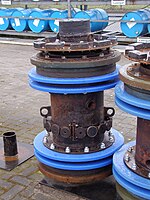
Photo from wikipedia
Abrasive water jet machining is a proficient alternative for cutting difficult-to-machine materials with complex geometries, such as austenitic stainless steel 304L (AISI304L). However, due to differences in machining responses for… Click to show full abstract
Abrasive water jet machining is a proficient alternative for cutting difficult-to-machine materials with complex geometries, such as austenitic stainless steel 304L (AISI304L). However, due to differences in machining responses for varied material conditions, the abrasive waterjet machining experiences challenges including kerf geometric inaccuracy and low material removal rate. In this study, an abrasive waterjet machining is employed to perform contour cutting of different profiles to investigate the impacts of traverse speed and material thickness in achieving lower kerf taper angle and higher material removal rate. Based on experimental investigation, a trend of decreasing the level of traverse speed and material thickness that results in minimum kerf taper angle values of 0.825° for machining curvature profile and 0.916° for line profiles has been observed. In addition, higher traverse speed and material thickness achieved higher material removal rate in cutting different curvature radii and lengths in line profiles with obtained values of 769.50 mm3/min and 751.5 mm3/min, accordingly. The analysis of variance revealed that material thickness had a significant impact on kerf taper angle and material removal rate, contributing within the range of 69–91% and 62–69%, respectively. In contrast, traverse speed was the least factor measuring within the range of 5–18% for kerf taper angle and 27–36% for material removal rate.
Journal Title: Applied Sciences
Year Published: 2021
Link to full text (if available)
Share on Social Media: Sign Up to like & get
recommendations!